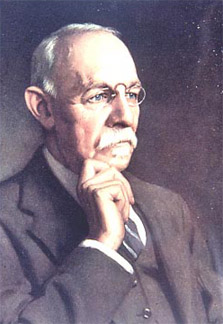| William Stewart Halsted  Born: 23-Sep-1852 Born: 23-Sep-1852
Birthplace: New York City
Died: 7-Sep-1922
Location of death: Baltimore, MD
Cause of death: Pneumonia
Remains: Cremated, Green-Wood Cemetery, Brooklyn, NY
Gender: Male
Religion: Agnostic
Race or Ethnicity: White
Sexual orientation: Straight
Occupation: Doctor Nationality: United States
Executive summary: Pioneer of sterile surgical technique Through intuition, study, and what now seems like simple common sense, Dr William Stewart Halsted was an early advocate and practitioner of sanitary surgical practice. Nineteenth century surgery was inherently dangerous, undertaken in only the most dire situations, because most surgical patients promptly developed infections and never recovered. Halsted's patients fared markedly better, because he insisted on meticulous cleanliness in the operating room and pioneered antiseptic procedures including the sterilization of all medical equipment.
He was born into a wealthy family, and had all the advantages of an elite private education before attending Yale. He earned his medical degree at Columbia University, spent two years studying in Europe, and established a respected practice in New York. His father, William Mills Halsted, Jr., was a principal of Halsted, Haines & Company, a leading dry goods supplier in New York, and evidence strongly suggests that the elder Halsted augmented his income by embezzling from the firm, which ensured the younger Halsted's education, overseas study, and personal fortune, and hastened the 1884 collapse into insolvency of Halsted, Haines & Company.
In 1877, while working at Bellevue Hospital in New York, he tried to convince hospital administrators to construct a sterile operating room. The hospital refused, as the proposal was wildly innovative and seriously expensive, so Halsted used $10,000 of his own funds to erect a tent on hospital grounds, equipped with maple floors, gas lights, and sterilization facilities — the first sterile operating environment in medical history.
In 1881, while visiting the family home in Albany, New York, he performed the first emergency blood transfusion, drawing his own blood and injecting it into his sister's bloodstream when he found her passed out from a postpartum hemorrhage. The next year he performed emergency gall bladder surgery on his mother, performing the operation on her kitchen table — administering ether to knock her out, sanitizing his hands and equipment by dipping them in carbolic acid, then slicing into her abdomen and gall bladder, draining vast amounts of pus and removing seven stones — the first recorded surgery to remove gallstones.
In 1882 he introduced the radical mastectomy as a surgical treatment for breast cancer. In 1884 he became the first surgeon to use cocaine as an injected anesthetic in the trunk of a sensory nerve, but in the course of developing this technique he became addicted to cocaine himself. In a subsequent but failed attempt to wean himself from cocaine he became addicted to morphine as well, and remained a regular user of both drugs for the rest of his life.
In 1886 he came to Baltimore at the invitation of Dr William H. Welch, and there he spent several years experimenting on dogs to improve surgical technique for intestinal suture and wound healing. In 1889 he was appointed chief of surgery at the newly established Johns Hopkins Hospital. In the same year, when his nurse complained that the antiseptic mercuric bichloride had caused dermatitis on her hands, he contracted with a rubber manufacturer to make the first surgical gloves. Within a few years he had introduced surgical gowns and hats. In 1892 he became professor of surgery at Johns Hopkins University, and performed the first successful subclavian artery ligation.
In his long career at Hopkins, Halsted introduced improved surgical techniques for aneurysms, goiters, hernia repair, intestinal sutures, thyroid surgery, and treatment of tuberculosis, and established the residency training system, as well an increased emphasis on limiting blood loss and minimizing tissue damage. He was also renowned as a teacher, and as his fame and success grew, virtually all of the next generation of American surgeons were taught either by Halsted, by his students, or by his methodology. Perhaps most remarkably, Halsted accomplished all this while maintaining a dark, delicate balance between his drug addictions and the pressures of academia and surgery.
His character was described as abrupt, eccentric, and introverted. He insisted on wearing only shoes and boots made by a particular leather craftsman in Europe, his suits were all tailored in London, and all his shirts came from a single tailor in Paris. He did not trust American laundries, and had his clothes shipped to Europe for cleaning. He married the head nurse at Johns Hopkins — the same woman whose skin problems inspired surgical gloves, she was a niece of Confederate General Wade Hampton. For decades Dr and Mrs Halsted lived on separate floors of a Baltimore mansion. They had no children but did own several dachshunds. Though raised a Presbyterian, by adulthood he proclaimed agnosticism. He died in 1922, of pneumonia ironically aggravated by complications from surgery for obstructive jaundice. Father: William Mills Halsted, Jr. (retailing magnate)
Mother: Mary Louisa Haines
Wife: Caroline Hampton (nurse, m. 4-Jun-1890)
Mistress: Elizabeth Blanchard Randall ("Bessie", b. 1892, affair 1918-22)
High School: Phillips Academy Andover (1869)
University: BA, Yale University (1874)
University: MD, Columbia University (1877)
Scholar: University of Vienna (1878-79)
Scholar: University of Leipzig (1879)
Scholar: University of Würzburg (1879-80)
Lecturer: Anatomy, Columbia University (1880-85)
Professor: Surgery, Johns Hopkins University (1892-1922)
Johns Hopkins Hospital, Baltimore Chief of Surgery (1889-1922)
Roosevelt Hospital, New York (1881-87)
New York Hospital, New York (1878)
Bellevue Hospital, New York (1876-78)
Gold Medal of the American Dental Association (1922)
American Academy of Arts and Sciences
American Surgical Association
Royal Chemical Society of England Foreign Member
Surgery Obstructive jaundice (26-Aug-1922)
English Ancestry
Risk Factors: Cocaine, Morphine, Smoking
Author of books:
Surgical Papers (1924, two volumes)
Requires Flash 7+ and Javascript.
Do you know something we don't?
Submit a correction or make a comment about this profile
Copyright ©2019 Soylent Communications
|